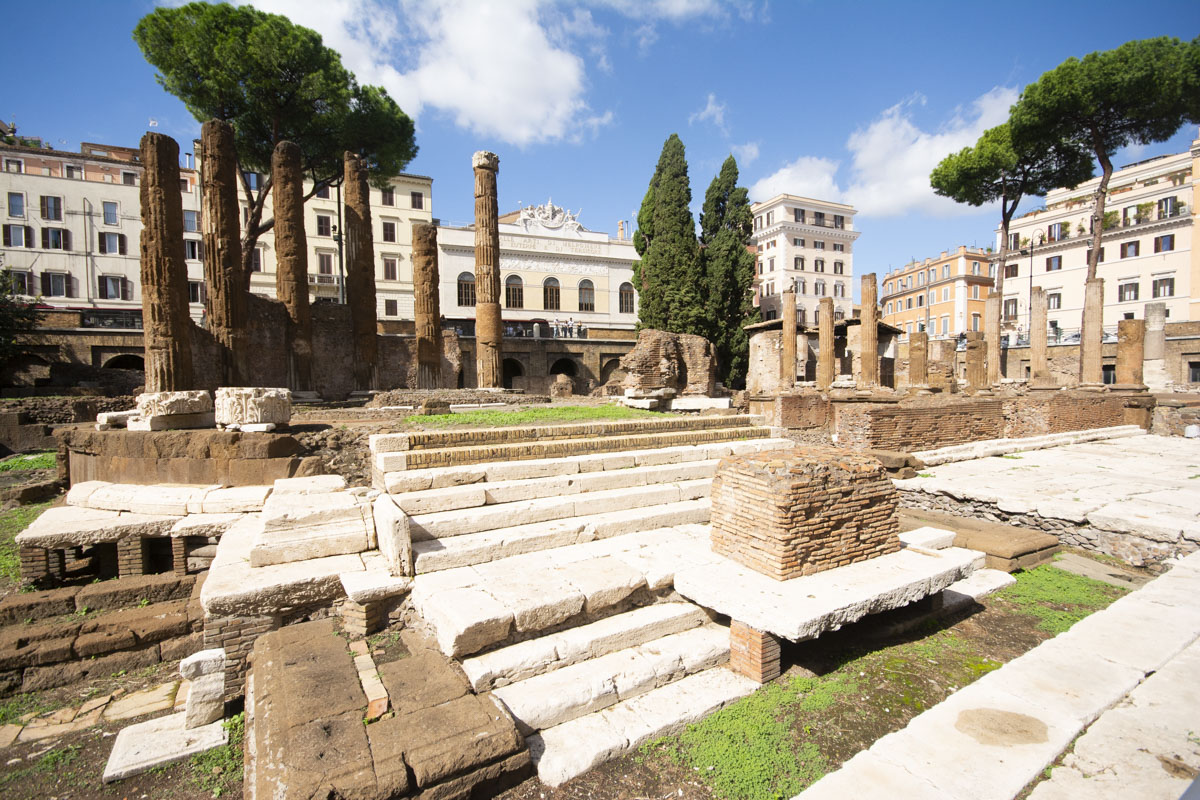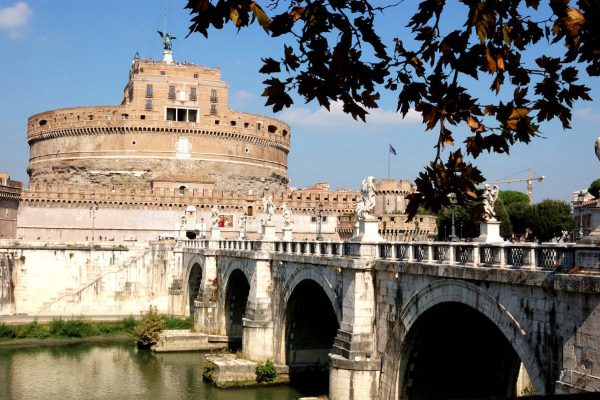It might come as a surprise, but there are a few archaeological sites in Rome that don’t teem with crowds and the Sacred Area of Torre di Largo Argentina is one of them.
You have probably gone past these important ancient ruins many times because right in the city center in a busy walking and bus hub. However, being in such a fast-paced piazza is probably why many overlook it.
Adding to that, this ancient sacred area has been open to visitors quite recently so a couple of years ago, it wasn’t even possible to access the area. You can also look at it from above in the street but obviously, the experience will be different.
We have recently visited the wonderful site of the Sacred Area of Largo di Torre Argentina and I’m writing this guide to show you what you will see there and also help you decide whether it’s worth visiting for you or not.

What to see in the Sacred Area of Largo di Torre Argentina
In almost 30 years of living in Rome, I can safely say that I have walked past the ruins of the Sacred Area of Largo di Torre Argentina quite a few thousand times. This archaeological site remained under restoration for decades and finally launched a new, user-friendly visiting path in 2023.
It was between 1926 and 1929, during the large urbanization project that brought to the demolition of the old neighborhood located between Via del Teatro Argentina, Via Florida, Via di San Nicola de’ Cesarini, and Corso Vittorio Emanuele II, that the ruins of this important sacred site were found.
The site immediately appeared as one of the most important archaeological complexes in the Campo Marzio area consisting of a large paved square and four temples.
As the name aptly reveals, this was an important sacred area in the ancient Campo Marzio neighborhood where they built four temples next to each other. The exact origins of these temples are still a subject of research for historians and archaeologists, so for now, we can only guess which deities they were devoted to.
As soon as you step into the archaeological site, you will enter a boardwalk that makes the path very walking-friendly. You will see each step numbered and the first section suggested in the visit is the covered exhibition where are collected all the pieces found during the excavation. These will include decorative pieces from the original temples, pillars, and walls, as well as more recent parts from medieval times.
Once you are done with this small exhibition, you can start your walk across the ruins. Detailed descriptive panels will help you understand what you are seeing and the importance of this area of Rome in imperial times.
The area where these temples were built was known as Campo Marzio, immediately out of the Servian Walls and the pomerium, the sacred limit of the ancient city. Originally, the Campo Marzio area was a property of the Tarquini dynasty but it became public after they were chased away and was used for military exercises.
The area was also linked to the myth of Romulus who, right from here during a military drill was called to be part of the gods’ assembly, and home to a temple devoted to Mars, the Roman god of war.
During Republican times, the urban planning of the area underwent several changes, including the construction of the huge Theater of Pompeo and the temples A, B, C, and D of this sacred area of Torre di Largo Argentina. The urbanization of the area carried on in the early imperial era with the erection of important buildings including the Pantheon, the Theater of Marcello, and the Mausoleum of Augustus, the funerary monument destined to be the burial place of the gens Julia dynasty.
Historians are not sure about the origins of the temples of the Sacred Area of Largo di Torre Argentina, and this is why they are classified by letters.
Discover all the archaeological sites in Rome!

Temple A of the Sacred Area of Largo di Torre Argentina
Historians are still debating over the origins of this temple. According to some, it was built by consul C. Lutazio Catulo in honor of Juturna in the aftermath of the victory against Carthago in 241 BC. Others attribute it to Feronia or Juno Curite.
The original building stood on a large tuff base with four frontal pillars and was accessible through a large staircase of 18 steps. With time, this temple underwent several changes. Its floor was raised and a large tuff pavement was laid in front of temples A and C. Later the complex was enlarged and the building was incorporated into a larger temple.
Temple B of the Sacred Area of Largo di Torre Argentina
Temple B is a round one and sits on a tall base. Most researchers agree that it was devoted to the goddess Fortuna huiusce dei and it was built by order of Consul Q. Lutazio Catulo after the battle of Vercelli in 101 BC ended the war against the Cimbri. Remains of a female divinity statue such as a foot, an arm, and a head were found and are now kept in the Centrale Montemartini Museum.
Originally, this temple was peripteros, round and surrounded by 18 tuff columns. Still, throughout the centuries, it underwent several changes, the most radical of which were due to the terrible fire of 80 AD under the rule of Emperor Domitian.
Temple C of the Sacred Area of Largo di Torre Argentina
Like temple A, temple C also dates back to the 3rd century BC. Historians agree that it was likely devoted to the goddess Feronia, a cult from the Sabine Hills because it was also introduced in Rome after the conquest of this area of the Lazio region.
The original structure featured four columns in the front and five on each side and stood on a square tuff base placed after a staircase of 20 steps. While the original dimensions and proportions remained mainly unchanged, this temple underwent a series of renovations throughout the centuries, including a radical one after the fire of 80 AD under Domitian.
Temple D of the Sacred Area of Largo di Torre Argentina
This temple can be viewed in the covered part of the archaeological site and is located under the current Via Florida. It was believed to have been erected in honor of the Nymphs or the Lari Permarini, the divinities protectors of sailing.
It dates back to the 2nd century BC, after temples A and C. Compared to the earlier temples, it is visibly larger. It’s believed the frontal part showed six columns and it was aligned with the other temples, but we don’t know much of the original structure because in the 1st century BC, it was completely renovated and enlarged.

Where Julius Caesar was killed
Apart from the temples, the Sacred Area of Largo di Torre Argentina has been recognized as the place where Julius Caesar was assassinated during a Senate meeting on the Ides of March 44 BC. Between temples B and C, more towards the street, at the time lay what was known as the Curia of Pompey, a large rectangular hall occasionally used by the Senate for gatherings.
Even though today these ruins are part of the archaeological site of Largo Argentina, in origins, the hall was inside a monumental complex known as Porticus Pompei, a series of gardens and porticoes leading to a theater and the temple of Venus Victorious.
At the center of the hall was a large statue of Pompeo, at the foot of which Julius Caesar fell under the stabbing of his assassins who had been conspiring against him. Such a statue was later moved to the theater because Augustus declared the place “sceleratus” (accursed) and banned it from any public use.
Check out the full video of our visit!
Is Largo Argentina for you? 5 reasons to visit
- You are a history buff. These ruins show an important sacred area of Ancient Rome so history and archaeology fans will love seeing the remains, what has been found during the excavations, and understand more about the purpose of the whole area.
- You like to discover new sites. The site of Largo Argentina has been opened to the public relatively recently and many travelers are yet to enter.
- You go beyond the crowded landmarks. Probably because you can see almost everything from outside, not many people enter, but I think it’s a pity because inside you will have all the explanatory panels and the covered exhibition.
- It’s inexpensive. The full adult ticket costs only 5€ and the site reveals much of the society of Ancient Rome so I think it’s a pretty good deal and perfect also if you are visiting Rome on a budget.
- You are exploring the city center. This is roughly located between the Pantheon, Campo de’ Fiori, and the Jewish Quarter so really hard to miss. Including it in your itinerary will definitely add value to your trip.
- You like cats! You might now know this but the archaeological park of Largo Argentina is home to a large cat colony, probably Rome’s most famous. Expect some furry felines to show up while walking around these ancient ruins.
Visiting the Sacred Area of Largo Argentina – Practical info
- Address: Largo di Torre Argentina.
- How to get there: Bus 30, 40, 46, 62, 64, 70, 81, 87, 190F, 492, 628, 916. Tram 8 (now 8BUS replaces the tram because of ongoing works in progress.
- Opening hours: Tuesday to Sunday 9.30 am-7 pm. From end of October to end of March until 4 pm. Last admission is an hour before closing. Closed on Monday, December 25th, January 1st, and May 1st.
- Admission fee: 5€.
WANT TO READ THIS LATER? PIN IT TO YOUR BOARD!






